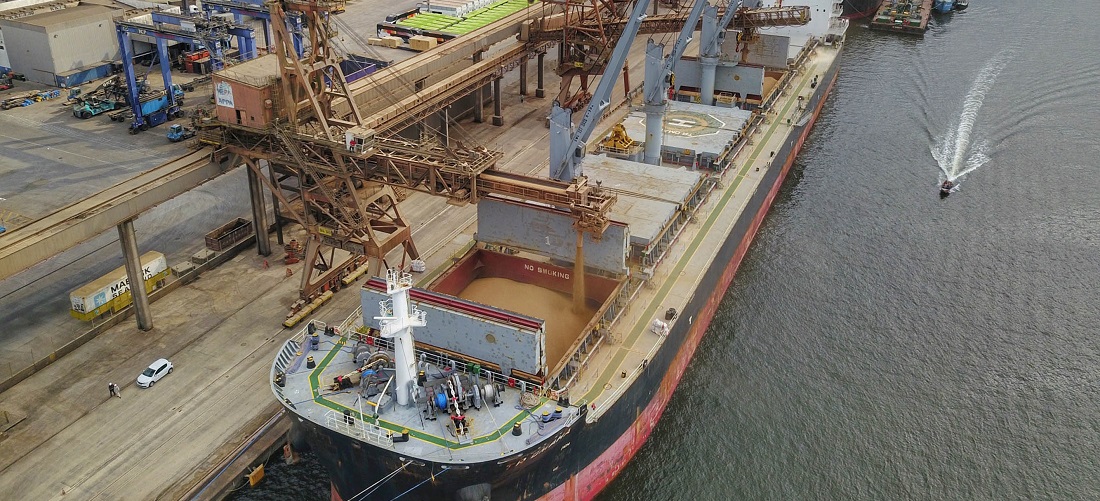
2020 Paraná exports total US$ 13.29 bi
Jan, 18, 2021 Posted by Ruth HollardWeek 202103
Data released last week by the Department of Trade and International Relations of Brazil’s Ministry of Agriculture and Food Supplies indicate that agribusiness exports from Paraná totaled US$ 13.29 billion in 2020, an increase of 3.98% over 2019 when the sector exported US$ 12.78 billion.
The state maintains the 3rd position in the 2020 national ranking of exports in the sector. Brazil added US$ 100.81 billion last year in agricultural foreign sales, and Paraná contributed 13.18% of the total. Mato Grosso led the ranking, with 17.73%, followed by São Paulo, with 17.09%.
The numbers also indicate that agribusiness has increased its participation in foreign trade in Paraná. In 2019, agribusiness made up 77.6% of exports. Now, it represents 80.9% of the total exported.
According to the State Secretary for Agriculture and Supply, Norberto Ortigara, the international recognition of Paraná (expected in May) as an area free of foot-and-mouth disease without vaccination should help boost exports.
With regard to imports, the state’s agribusiness also ranks 3rd in the national ranking, behind São Paulo and Santa Catarina. In 2020, Paraná agribusiness imported US$ 1.7 billion.
Highlights – Soy is one of Paraná’s most exported products; 17.3 million tons were exported in 2020, an increase of 28.4% in relation to the volume exported in 2019, US$ 6.05 billion. Approximately 45.5% of the sector’s exports through Paraná correspond to this category. Meat represents 21% of exports and forest products 16.67%.
External sales of meat (beef, pork, and chicken) reached 1.84 million tons, which generated US$ 2.79 billion. Beef amounted to 28,000 tons valued at US$ 112.6 million. Chicken totaled 1.66 million tons, equivalent to 40% of the total Brazilian volume, valued at US$ 2.4 billion; and pigs 136,700 tons, a growth of 15.9%, totaling US$ 300.6 million. China and the United Arab Emirates are two of the main destinations for products from Paraná.
Another product with significant growth in exports was sugar, reaching 3.04 million tons exported. There was also an increase in foreign sales of fruit and cassava starch.
See the charts below for a comparison of soy and sugar exports via the Port of Paranaguá in 2019 and 2020:
Soy Exports (HS 1201) via the Port of Paranaguá | Jan to Nov 2019-2020 | WTMT
Source: DataLiner
Sugar exports (HS 1701) via the Port of Paranaguá | Jan to Nov 2019-2020 | WTMT
Source: DataLiner (To request a DataLiner demo click here)
The state’s performance follows the national trend. Brazilian agribusiness exports totaled US$ 100.81 billion in 2020, a growth of 4.08%, and represented 48% of Brazilian exports. This is the second-highest value registered, behind only 2018, when US$ 101.17 billion were exported.
Imports of agribusiness products fell by 5.2% to US$ 13.05 billion. The increase in exports and the fall in imports resulted in a trade surplus of US$ 87.76 billion for Brazilian agribusiness.
The soy complex was the main item exported, reaching 101.04 million tons valued at US$ 35.24 billion. Meats occupied the second position, valued at US$ 17.16 billion. Sales of beef corresponded to 49.4% of this amount, with an increase of 11.1% in comparison with the previous year. Chicken represents 34.9% of the total exported by the meat sector in Brazil in 2020, totaling US$ 5.99 billion. Foreign sales of pork totaled US$ 2.25 billion, of which 94.1% corresponded to fresh pork.
China acquired 73.2% of the soybeans exported by Brazil (US$ 20.91 billion). The Asian country was also the main destination for exported fresh beef, totaling 54.2% (US$ 4.04 billion).
-
Ports and Terminals
Mar, 05, 2024
0
TCP Leads Market Share In Packaging Exports
-
Trade Regulations
Jul, 03, 2024
0
Brazil closes partnership with Amazon to boost export culture among local entrepreneurs
-
Meat
Jul, 31, 2024
0
Brazil negotiates market access for chicken, fish, and dairy products with Guatemala
-
Economy
Feb, 07, 2022
0
Trade balance has surplus of US$ 754.5 million in the 1st week of February


